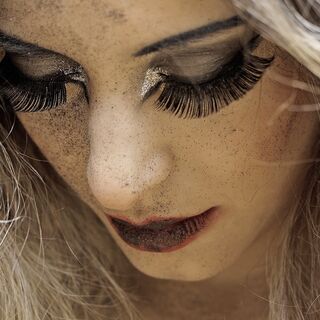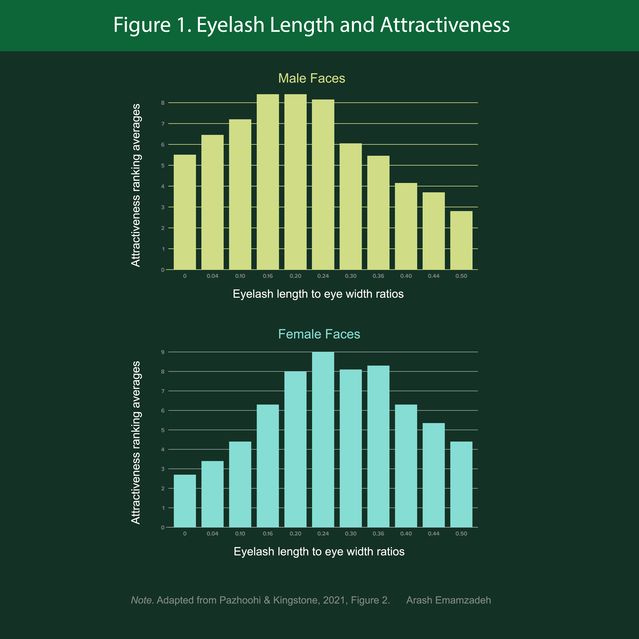Beauty
What's the Most Attractive Eyelash Length?
Exploring the association between eyelash length and attractiveness.
Posted March 31, 2021 Reviewed by Ekua Hagan
Key points
- The relationship between eyelash length and attractiveness may be described with an inverted-U function, a recent study suggests.
- On female faces, longer lashes were found to be more attractive than short. On men, very long lashes were least attractive.
- The most attractive eyelash ratio differed between men and women, suggesting the impact of sociocultural factors in addition to biological ones.

Human beings form judgments about people very quickly. Just by looking at a person’s face, we may make initial evaluations—accurate or not—of an individual’s personality, values, and other characteristics. More commonly, we use facial features to judge attractiveness, and eyes and eyelashes play a big part in such assessments.
A new study, by Pazhoohi and Kingstone, in press in Evolutionary Behavioral Sciences, examines how eyelash length affects ratings of beauty and attractiveness.
The importance of eyelashes as indicators of health and beauty
Thick and long eyelashes are associated not only with beauty but also with femininity—hence the idiom “fluttering one’s eyelashes,” which means to flirt.
Women use a variety of methods to emphasize their eyes and enhance the length of their eyelashes: eyeshadow, mascara, eyeliners, eyelash curlers, eyelash extensions, false eyelashes, magnetic eyelashes, and even eyelash transplants. Some drugs have also been used to help grow longer, thicker, and darker eyelashes.
If long lashes are associated with attractiveness, does it follow that very long lashes are even more attractive? Not necessarily. Very long lashes are associated with a number of disorders (e.g., Cornelia de Lange syndrome) or can be a side effect of drugs (e.g., prostaglandin analogues).
Functions of eyelashes
An important question is why we have eyelashes. In other words, what is the function of eyelashes?
A previous study suggests the main function of eyelashes is related to the tear duct system, which “provides a thin composite layer of mucus, oil, and water to lubricate the eyelid, hydrate the cornea and remove particles deposited onto the eye.”
It also found eyelashes were approximately one-third of the eye’s width in the 22 mammalian species examined. What seems to be special about this eyelash length is that it “reduces both deposition of airborne particles and evaporation of the tear film by a factor of two.”
Might this ratio be associated with attractiveness too? In other words, might the reason we find relatively long lashes attractive be related to the benefits they provide in protecting the eyes? To explore the possibility, let us review the findings of the new study.
The Eyelash Length and Attractiveness Study
Methods
Kingstone and Pazhoohi instructed the participants, who were Canadian college students, to rank computer-generated faces in terms of attractiveness. For the task of ranking the female faces, the researchers recruited a total of 84 students, of an average age of 20 years (18-30 years range). For the male faces, they used a sample of 51 students, of an average age of 22 years (18-45 years range).
The male and female faces were created using software called Daz3D. Then, using Photoshop, 11 versions of each face were generated, with the main difference being the length of the eyelashes. Specifically, the ratio of eyelash length to eye-width varied from 0.00, 0.04, 0.10, 0.16, 0.20, 0.24, 0.30, 0.36, 0.40, 0.44, to 0.50.
Participants were shown 11 print copies, randomly stacked, of either a male or female face. They were then asked to order the pictures based on facial attractiveness, from least to most attractive.
Results
Female faces:
A one-way analysis of variance (ANOVA) was calculated and showed that eyelash length to eye-width ratios of 0.20, 0.24, 0.30, and 0.36 were considered most attractive. Less attractive were ratios of 0.16, 0.40, and 0.44. The least attractive were ratios of 0.00 and 0.04.
Male faces:
A one-way ANOVA test was conducted, showing most attractive faces had eyelashes with 0.16 and 0.20 ratios. The least attractive were those with ratios of 0.44 and 0.50.
Further analysis, comparing the attractiveness of faces as a function of eyelash length, showed, “individuals ranked males faces as higher on attractiveness than females at the smaller eyelash length ratios [0.00 and 0.04], and they ranked female faces as higher on attractiveness than males for the larger eyelash ratios [0.30, 0.36, 0.40, and 0.50].”

Takeaway
Let us summarize (see Figure 1):
Ratings of facial attractiveness were higher for male faces with eyelash length to eye-width ratios of 0.10, 0.16, 0.20, and 0.24, while for female faces, the most attractive ratios were 0.20, 0.24, 0.30, and 0.36.
The findings do not support the view that increasing the length of eyelashes will always increase the attractiveness of female faces. Yes, attractiveness increases, but only up to a point, after which it declines. For female faces, long eyelashes are certainly more attractive than very short eyelashes (being the least attractive) but they are also somewhat more attractive than very long eyelashes.
For male faces, however, very long eyelashes are least attractive. Even faces with no eyelashes are more attractive than ones with very long lashes. This finding disagrees with the idea discussed earlier, that the optimal ratio for attractiveness, regardless of sex/gender, is 0.35 ± 0.15.
So perhaps the link between eyelash length and facial attractiveness is not due purely to biological factors. The authors state, “while in general eyelashes of an optimum ratio are considered more attractive, this preference is not solely a biologically adaptive phenomenon, and is influenced by cultural norms.” For example, compared to societies where mascara or eyeliners are used by men or children too, other ratios might be considered more attractive.




